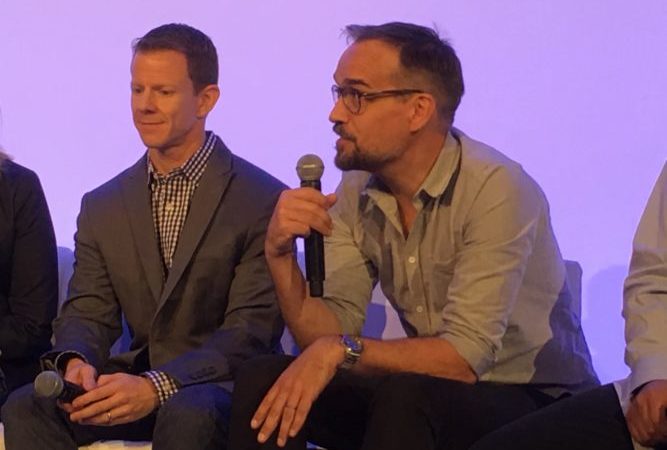M+E Daily

Industry Execs: More Streaming Remains Key to High-Res Audio Success
Story Highlights
NEW YORK — High-resolution audio offers significant opportunities for the music industry and CE manufacturers, but if it’s going to really take off, there’s going to have to be a lot more content made available to consumers via streaming, industry executives said at the CE Week conference June 23.
The Master Quality Authenticated (MQA) format presents one feasible way to do that, they said. But no major record label has made music available in that format yet, while Onkyo and its Pioneer brand are the only mainstream consumer brands that have shipped devices — one portable player each — supporting MQA.
Universal Music Group (UMG) has been supporting high-res audio downloads in general for 3-4 years and has about 6,000-7,000 titles so far, said Jim Belcher, VP of technology and production for UMG’s global digital business. Most of the high-res titles that Sony Music Entertainment offers, meanwhile, are pop rock, though jazz is the most popular genre in high-resolution audio, said Mark Piibe, its EVP of global business development and digital strategy.
So far, when it comes to the digital distribution of high-res audio content, the focus has clearly been on downloads. “But most recently, of course, the industry is moving to streaming: on-demand music wherever you go, whatever device you have,” said Marc Finer, senior director of DEG: The Digital Entertainment Group.
MQA, therefore, is “certainly important” to Warner Music Group, Howie Singer, its SVP and chief strategic technologist, said at the conference, pointing out his company was the first major record label to license that technology.
It comes down to giving consumers what they want, Singer said. “The digital music age has been, from the start, about convenience,” he said. “Part of the reason that so many millions of consumers prefer streaming as their experience is that the collective catalogs of the three major labels and indie labels around the world are essentially in the palm of your hand” via Spotify, Pandora and other smartphone apps, he said. “That convenience of streaming is something that consumers are voting for with their pocketbooks [and] with their wallets,” he said.
Therefore, “having a technology like MQA, which enables streaming of a high-res experience with the same bit rates that it would take to deliver the bits off the CD means that streaming” of high-resolution audio is “feasible today,” Singer said. “So, we think this is a chance to take what is a great listening experience and bring it to” audio devices and smartphones, he said.
UMG sees MQA as an “exciting technology” that addresses the bandwidth requirements for the transport of high-resolution audio streaming, Belcher said. UMG has “not officially signed on to MQA yet – we’re still in the business terms” stage, he said. MQA can also be used for mastering, but “we’re not looking at that right now,” just the “transport solution,” he said.
Sony’s Piibe agreed about the benefits of MQA, adding he would “love to see MQA in the market,” calling the codec a “piece of the puzzle” that provides a viable transport protocol for high-resolution audio and adoption by music streaming services that “have access to a lot of consumers,” he said. Also key, however, are more content and more compatible devices, and “when you have all those pieces of the puzzle together, I think you have a real viable offering to a much larger portion of the population” than those who are using high-resolution audio now, he said, adding “I think we can get there.”
 The Recording Academy has been “following this very closely,” Maureen Droney, managing director of its Producers & Engineering Wing, said at the conference, adding she worked with people who were “really picky about technology and what it does to their recordings.”
The Recording Academy has been “following this very closely,” Maureen Droney, managing director of its Producers & Engineering Wing, said at the conference, adding she worked with people who were “really picky about technology and what it does to their recordings.”
Feedback about MQA was promising so far, she said, pointing out one member she didn’t name was recently “pretty astonished by how good” the format sounded. Therefore, the Recording Academy was “optimistic that this is going to be something that helps move” high-resolution audio “along even faster,” she said.
“People are hearing a difference,” said Kevin Brannan, director of marketing at Onkyo USA, pointing out his company updated its $799 DP-X1 digital music player a month ago to support MQA.
Although there are a significant number of consumers who are willing to pay extra to listen to their music in high-resolution, it’s not for everybody, Singer said, adding: “If you’re a casual music fan, it’s probably not the best product for you.”
Execs: Virtual Reality Content is Key
Similarly, virtual reality (VR) and augmented reality (AR) offer significant opportunities for content creators and device makers, but whether those technologies become more than just a fad will largely be determined by how much content that consumers actually want becomes available, according to industry executives at the conference.
“Content in general is needed for VR and AR to succeed,” said Matt Sailor, CEO of 360-degree camera maker IC Real Tech. The concept of 3D TV was “not a bad idea,” he said, adding that one problem was “the lack of content.” Consumers “got kind of tired of watching the same experience over and over,” he said. The “key” with VR and AR is “to allow the user to create their own content in that immersive fashion” that they can then share socially with friends, he said.
Video games clearly offer opportunities for VR. But VR content that enables users to sit on their couch and become immersed in parts of the real world that they have not been to could attract a wide range of consumers, Sailor said. “When you can live in an area that you’ve not visited and you feel as if you’re truly there,” that is a potentially winning application for the technology, he said.
Live events also mark a big opportunity for 360-degree video, said Paul Meyhoefer, VP of marketing and planning at camera maker JK Imaging. “I fully expect to see live streaming becoming very readily available,” he predicted.
It’s also important for content creators to make sure there is low latency and that the video is presented “at a fast enough speed to keep your eye very comfortable,” to avoid the possibility of nausea by a user wearing a VR device, said Dan O’Brien, VP of VR planning and management at manufacturer HTC. HTC collaborated with game developer and digital distributor Valve on the new Vive VR headset. “It’s harder to induce a nausea effect in an AR environment” because the user can still see the real world when viewing AR content, he said.









